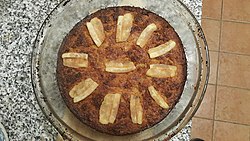 Babka ziemniaczana made according to traditional recipe from Podlasie, Poland. | |
| Type | Pie or pudding |
|---|---|
| Place of origin | Possibly Belarus |
| Main ingredients | Potatoes, eggs, onions, bacon |

Potato babka is a savoury dish, popular especially in Belarus [1] and northeastern Poland, where it is known as babka ziemniaczana. [2] It is made from grated potatoes, eggs, onions, and pieces of smoked, boiled or fried bacon and (especially in Poland) sausage. It is oven-baked in a crock, and often served with a sauce of sour cream and pork flitch. Depending on recipe and cooking method, it may be either a flaky potato pie or a heavy potato pudding. [1]
Contents
In 2016, the claimed world's largest potato babka, 2 meters in diameter, was baked in the village of Sula, Belarus. [3]